Build an Edinburgh Console Table
A Gorgeous Console Table That Is Easy to Build!
This is a very versatile table (as far as style goes!) and it has so much storage space! The DIY plans to build an Edinburgh console table are easy to construct and feature five roomy drawers as well as two shelves. This build can also be completed in a weekend!
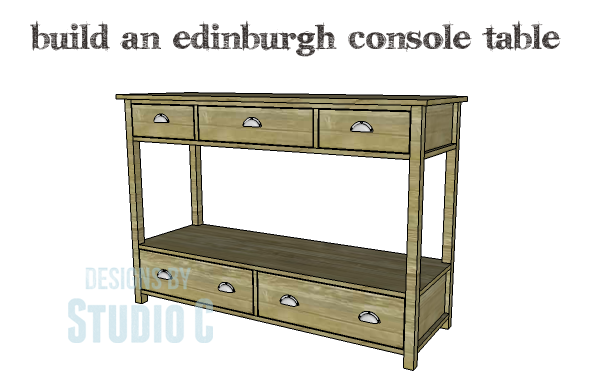
Materials:
- 1-1/4″ pocket hole screws (<– affiliate link!)
- 1-1/4″ brad nails
- Edge banding, optional
- 5 sets of 16″ Drawer slides
- Cabinet pulls
- Wood glue
- Sandpaper (100, 150, 220 grits)
- Finishing supplies (primer & paint, or stain, sealer)
Lumber:
- 1 – 1×2 at 6′
- 2 – 1×4 at 8′
- 2 – 1×6 at 8′
- 2 – 2×2 at 8′
- 2 – 4′ x 8′ sheets of 3/4″ plywood
Cut List:
- 3 – 3/4″ plywood at 18″ x 54″ – Shelves
- 4 – 2×2 at 37-1/4″ – Legs
- 2 – 3/4″ plywood at 7-3/4″ x 15″ – Lower Sides
- 1 – 3/4″ plywood at 7-3/4″ x 51″ – Lower Back
- 1 – 3/4″ plywood at 7-3/4″ x 16-1/2″ – Lower Divider
- 2 – 3/4″ plywood at 6-1/2″ x 15″ – Upper Sides
- 1 – 3/4″ plywood at 6-1/2″ x 51″ – Upper Back
- 1 – 1×2 at 51″ – Upper Stretcher
- 2 – 3/4″ plywood at 6-1/2″ x 16-1/2″ – Upper Dividers
- 1 – 3/4″ plywood at 19″ x 56″ – Top
- 2 – 3/4″ plywood at 11-1/2″ x 14-1/2″ – Upper Drawer Box Bottom
- 1 – 3/4″ plywood at 14-1/2″ x 19″ – Center Drawer Box Bottom
- 2 – 3/4″ plywood at 14-1/2″ x 22-5/8″ – Lower Drawer Boxes
- 6 – 1×4 at 14-1/2″ – Upper & Center Drawer Box Sides
- 4 – 1×4 at 13″ – Upper Drawer Box Front & Back
- 2 – 1×4 at 20-1/2″ – Center Drawer Front & Back
- 4 – 1×6 at 14-1/2″ – Lower Drawer Box Sides
- 2 – 1×6 at 24-1/8″ – Lower Drawer Box Front & Back
- 2 – 3/4″ plywood at 5-1/2″ x 13-3/4″ – Upper Drawer Fronts
- 1 – 3/4″ plywood at 5-1/2″ x 21-1/4″ – Center Drawer Front
- 2 – 3/4″ plywood at 7-1/2″ x 24-7/8″ – Lower Drawer Front

Step One
Edge banding will be applied to the exposed edges of the plywood prior to assembly.
Cut the pieces for the shelves and cut the notches using a jigsaw. Using a portable pocket hole jig set for 3/4″ material, drill pocket holes in the notches as shown.
Cut the pieces for the legs. Secure the legs to each notch of one of the shelves using glue and 1-1/4″ pocket hole screws.
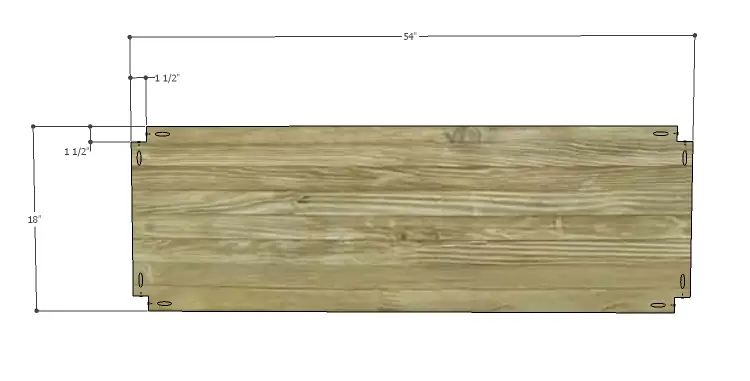
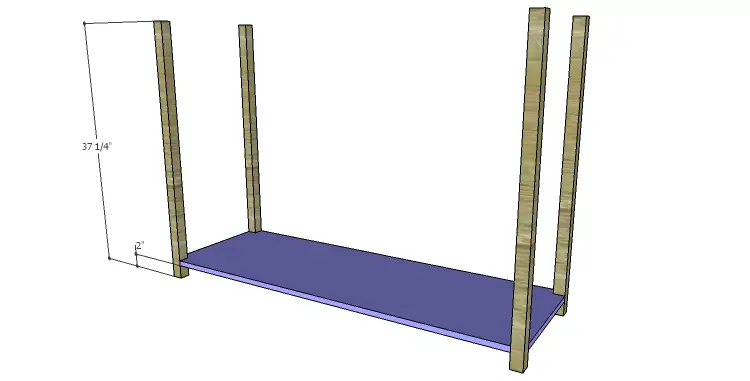
Step Two
Cut the pieces for the lower sides and lower back. Drill pocket holes in each end and one long edge of each piece. Secure the sides and the back to the legs and shelf using glue and 1-1/4″ pocket hole screws. The back face (with the pocket holes) will be flush with the inside faces of the legs.
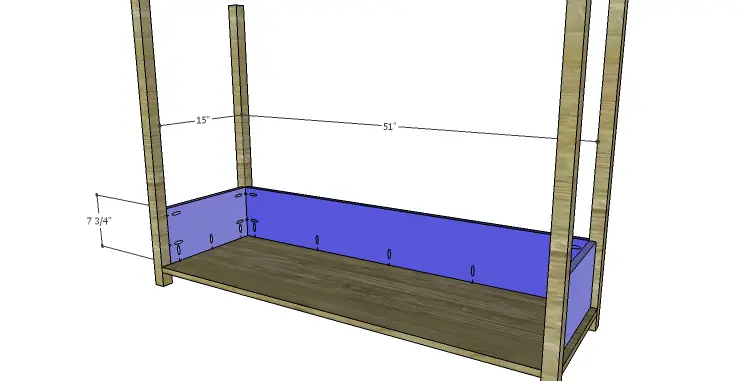
Step Three
Cut the piece for the lower divider. Drill pocket holes in one long edge and one short edge. Secure the divider to the back and shelf as shown using glue and 1-1/4″ pocket hole screws.
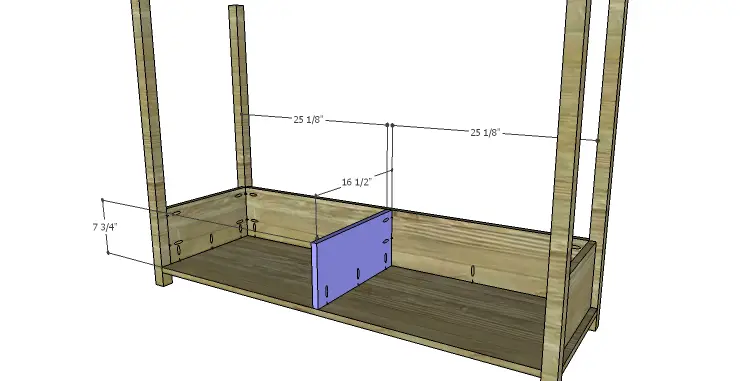
Step Four
Position one of the shelves on top of the lower sides and back. Secure the shelf in place using glue and 1-1/4″ brad nails through the shelf into the lower sides, lower back, and lower divider.
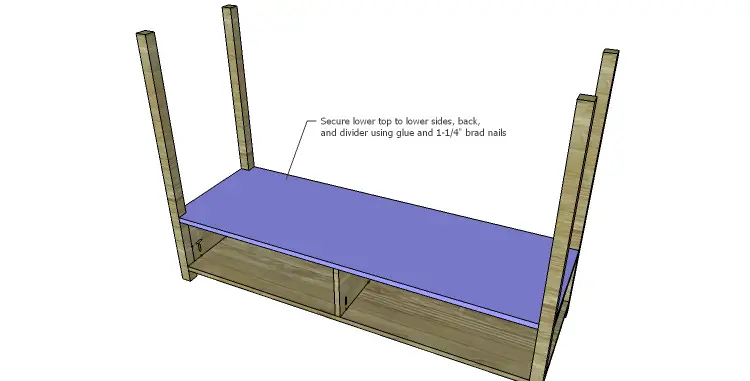
Step Five
Secure the third shelf to the legs as shown using glue and 1-1/4″ pocket hole screws.
Cut the pieces for the upper sides and upper back. Drill pocket holes in each end and one long edge of each piece. Secure the sides and the back to the legs and shelf using glue and 1-1/4″ pocket hole screws. The back face (with the pocket holes) will be flush with the inside faces of the legs.


Step Six
Cut the piece for the upper stretcher and drill pocket holes in each end. Secure the stretcher to the legs using glue and 1-1/4″ pocket hole screws.
Cut the pieces for the upper dividers and cut the notch in each piece with a jigsaw. Drill pocket holes in one long edge and one short edge of each piece. Secure the dividers to the back and bottom using glue and 1-1/4″ pocket hole screws. Add a few brad nails through the stretcher into the notch of the dividers.
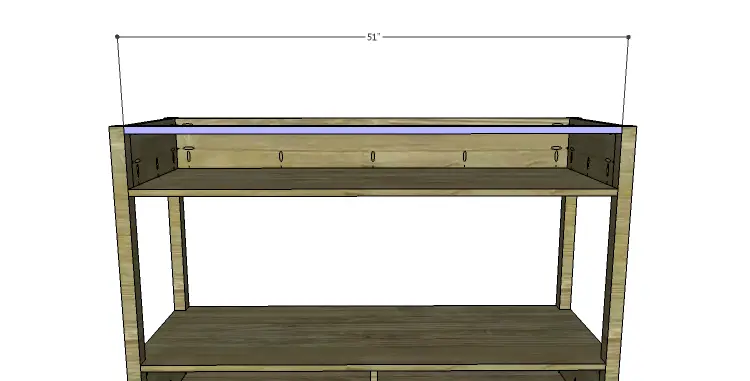

Step Seven
Cut the piece for the top. The sides and front will overhang by 1″. Secure the top in place using glue and 1-1/4″ brad nails.
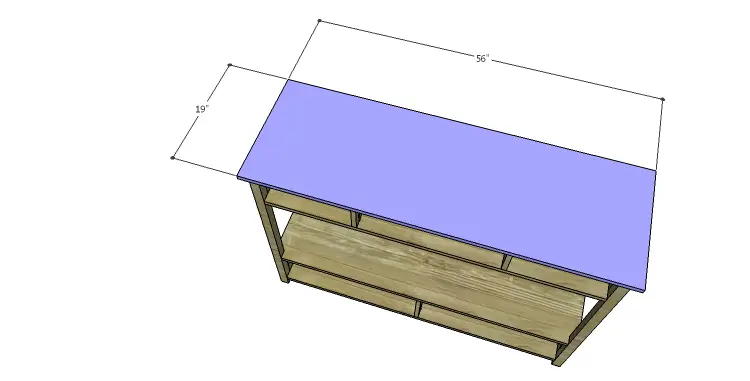
Step Eight
Cut the pieces for the drawer boxes. Drill pocket holes in all four edges of the bottom as well as each end of the sides. Assemble the drawer boxes as shown using glue and 1-1/4” pocket hole screws. Install the drawer slides according to the manufacturer’s installation instructions, locating them ¾” back from the front edge of the sides. This tutorial on installing drawer slides will be helpful. Make any necessary adjustments.
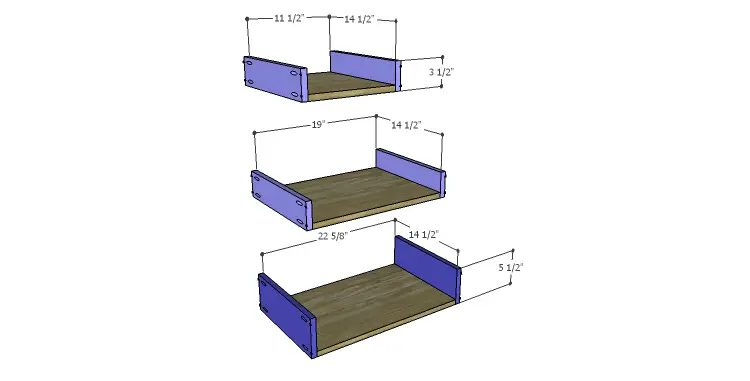
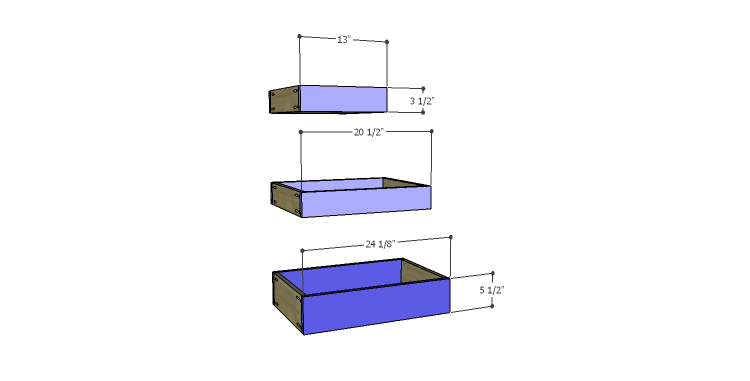
Step Nine
Cut the pieces for the drawer fronts. Mark the position for the drawer pulls and drill the holes. Shim the drawer front in the opening – there will be a 1/8” gap around all sides – then drive screws through the holes for the drawer pulls into the drawer box. Open the drawer, and secure the drawer front using countersunk 1-1/4” screws from the inside. Remove the screws from the holes for the drawer pull then finish drilling the holes. Install the drawer pull. Take a look at this tutorial on installing drawer fronts.

Finish as desired.
The console table would be a great addition to a bedroom as a dresser, in an entryway as storage, or in the dining room to store (or display) linens and china! Have any questions about the DIY plans to build an Edinburgh Console table? Leave a comment below or contact me at cher {at} designsbystudioc {dot} com!
Originally posted 2014-09-15 08:00:26.
